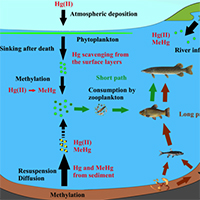Mercury methylation in oxic aquatic macro-environments: a review

Accepted: 27 February 2021
HTML: 106
All claims expressed in this article are solely those of the authors and do not necessarily represent those of their affiliated organizations, or those of the publisher, the editors and the reviewers. Any product that may be evaluated in this article or claim that may be made by its manufacturer is not guaranteed or endorsed by the publisher.
Authors
Mercury methylation in aquatic environments is a key process that incorporates this neurotoxin into the food chain and ultimately the human diet. Mercury methylation is considered to be essentially biotic and mainly driven by sulfate-reducing bacteria present in the bottom sediments in aquatic systems. However, in recent decades, many researchers have shown that this methylation also occurs in oxic layers in conjunction with a high content of particulate organic matter and localized depletion of dissolved oxygen. The goals of this review are to summarize our current understanding of Hg methylation in water columns of both marine and freshwater environments, as well as to highlight knowledge gaps and future research needs. Most of the literature showed that suspended particles (known as marine and lake snow) could be the microenvironment in which Hg methylation could occur across oxic water columns, because they have been recognized as a site of organic matter mineralization and as presenting oxygen gradients around and inside them. To date, the majority of these studies concern marine environments, highlighting the need for more studies in freshwater environments, particularly lacustrine systems. Investigating this new methylmercury production environment is essential for a better understanding of methylmercury incorporation into the trophic chain. In this review, we also propose a model which attempts to highlight the relative importance of a MeHg epilimnetic path over a MeHg benthic-hypolimnetic path, especially in deep lakes. We believe that this model could help to better focus future scientific efforts in limnic environments regarding the MeHg cycle.
Edited by
Diego Fontaneto, CNR-IRSA, Verbania, ItalyHow to Cite

This work is licensed under a Creative Commons Attribution-NonCommercial 4.0 International License.
Similar Articles
- Cristiana Callieri, María B. Sathicq, Pedro J. Cabello-Yeves, Ester M. Eckert, Justo Salvador Hernández-Avilés, TEP production under oxidative stress of the picocyanobacterium Synechococcus , Journal of Limnology: Vol. 78 No. 3 (2019)
- Cristiana CALLIERI, John G. STOCKNER, Freshwater autotrophic picoplankton: a review , Journal of Limnology: Vol. 61 No. 1 (2002)
- Carla BONACINA, Has Lake Orta completely recovered from its heavy polluted condition? A seventy years long history , Journal of Limnology: Vol. 60 No. 2 (2001)
- Anna VISCONTI, Marina MANCA, The invasive appearance of Eudiaptomus gracilis (G.O. Sars 1863) in Lago Maggiore , Journal of Limnology: Vol. 69 No. 2 (2010)
- Thomas KUMKE, Marta KSENOFONTOVA, Luidmila PESTRYAKOVA, Larisa NAZAROVA, Hans-Wolfgang HUBBERTEN, Limnological characteristics of lakes in the lowlands of Central Yakutia, Russia , Journal of Limnology: Vol. 66 No. 1 (2007)
- Anamarija Ridl, Marina Vilenica, Marija Ivković, Aleksandar Popijač, Ignac Sivec, Marko Miliša, Zlatko Mihaljević, Environmental drivers influencing stonefly assemblages along a longitudinal gradient in karst lotic habitats , Journal of Limnology: Vol. 77 No. 3 (2018)
- Sven E. JØRGENSEN, The application of models to find the relevance of residence time in lake and reservoir management , Journal of Limnology: Vol. 62 No. s1 (2003): Residence Time in Lakes: Science, Management, Education
- Aldo ZULLINI, Fabio GATTI, Roberto AMBROSINI, Microhabitat preferences in springs, as shown by a survey of nematode communities of Trentino (south-eastern Alps, Italy) , Journal of Limnology: Vol. 70 No. s1 (2011): Springs: neglected key habitats for biodiversity conservation
- Marina Vilenica, Natalija Vučković, Zlatko Mihaljević, Littoral mayfly assemblages in South-East European man-made lakes , Journal of Limnology: Vol. 78 No. 1 (2019)
- Michael SCHAGERL, Irene DROZDOWSKI, David G. ANGELER, Thomas HEIN, Stefan PREINER, Water age – a major factor controlling phytoplankton community structure in a reconnected dynamic floodplain (Danube, Regelsbrunn, Austria) , Journal of Limnology: Vol. 68 No. 2 (2009)
<< < 69 70 71 72 73 74 75 76 77 78 > >>
You may also start an advanced similarity search for this article.
-
Juanjo RodríguezFrontiers in Marine Science : 2023
-
Thibaut Cossart, Javier Garcia-Calleja, João P. Santos, Elaheh Lotfi Kalahroodi, Isabelle A. M. Worms, Zoyne Pedrero, David Amouroux, Vera I. Slaveykova, Kevin WilkinsonEnvironmental Chemistry : 2022
-
Eric Capo, Claudia Cosio, Elena Gascón Díez, Jean-Luc Loizeau, Elsa Mendes, Thierry Adatte, Sören Franzenburg, Andrea G. BravoWater Research : 2023
-
Laura Marziali, Roberta Piscia, Lucia Valsecchi, Claudio Roscioli, Marina MancaWater : 2022
-
Laura Balzer, Carluvy Baptista-Salazar, Sofi Jonsson, Harald BiesterBiogeosciences : 2023
-
Diva Scuvée, Marisol Goñi-Urriza, Claire Gassie, Bahia Khalfaoui-Hassani, Rémy GuyoneaudMicrobiological Research : 2023
-
María del Carmen Diéguez, Marina Arcagni, Andrea Rizzo, Soledad Pérez Catán, Carolina Soto Cárdenas, Milena Horvat, Sergio Ribeiro GuevaraNatural and Social Sciences of Patagonia : 2022
-
Vincent Noël, Kristin Boye, Hannah R. Naughton, Emily M. Lacroix, Meret Aeppli, Naresh Kumar, Scott Fendorf, Samuel M. WebbFrontiers in Environmental Chemistry : 2024
-
Daniel González-Reguero, Marina Robas-Mora, Agustín Probanza Lobo, Pedro Antonio Jiménez GómezWorld Journal of Microbiology and Biotechnology : 2023

 https://doi.org/10.4081/jlimnol.2021.2007
https://doi.org/10.4081/jlimnol.2021.2007





